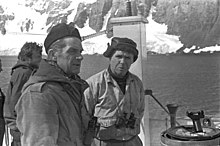Mike Sadler | |
|---|---|
 | |
| Born | 22 February 1920 London, England |
| Died | 4 January 2024 (aged 103) Cambridge, England |
| Military career | |
| Rank | Major |
Major Willis Michael Sadler, MC, MM (22 February 1920 – 4 January 2024) was a British Army officer. He was the last original member of the Special Air Service and the last survivor of the Long Range Desert Group (LRDG).[1][2][3]
Willis Michael Sadler was born on 22 February 1920 in Kensington, London, England to Adam and Wilma Sadler. When his father moved to Stroud, Gloucestershire to manage a plastics factory, the family moved to the nearby village of Sheepscombe.[4] Sadler attended the Oakley Hall School in Cirencester and the Bedales School in Petersfield, Hampshire, graduating in 1937.[5]
In 1937, Sadler moved to Southern Rhodesia (now Zimbabwe) to work on a tobacco farm. When World War II began in 1939, he enlisted in a Rhodesian regiment anti-tank unit of the British Army that would fight Erwin Rommel's Afrika Korps along the Egypt-Libya border.[5] He was rapidly promoted to sergeant.[4]
While on leave in Cairo, Egypt, Sadler convinced members of the recently assembled Long Range Desert Group (LRDG) that he could serve as their truck convoys' celestial navigator. In this role, he guided Special Air Service commandos across the Libyan Desert for nighttime raids on Axis airfields and bases. He utilized a theodolite to identify the group's position, even on the uneven terrain of sand dunes.[5]
During his first assignment with the LRDG, Sadler navigated the Special Air Service across more than 400mi (643.74km) of desert between the Jalo Oasis in Cyrenaica, Libya, and the Axis airfield in Tamet, Libya, allowing the British Army to destroy twenty-four aircraft and kill dozens of German and Italian pilots. Soon after, he was promoted to corporal and awarded the Military Medal.[5]
In the July 1942 raid on the Sidi Haneish Airfield in Egypt, Sadler navigated eighteen jeeps, each armed with four Vickers K machine guns, to victoriously destroy thirty-seven German aircraft. However, during an attempted raid on Benghazi as part of Operation Bigamy in September 1942, the Long Range Desert Group was unable to avoid Italian reconnaissance, resulting in the loss of seventy armed vehicles.[5]
In January 1943, SAS founder David Stirling sought to lead a small group through the Tebaga Gap and meet with the British First Army for Operations Vulcan and Strike against Axis forces in Tunis, Tunisia. While Stirling and ten of the soldiers were captured by German forces, Sadler escaped with two others, walking 110mi (177km) without food and water until they reached the French Foreign Legion and American 26th Infantry Regiment in Tozeur, Tunisia. Lieutenant Colonel John W. Bowen suspected the trio were German spies, but Sadler eventually negotiated his release to join the British Eighth Army for the remainder of the Western Desert campaign.[6]
Soon after the June 1944 Normandy landings, Sadler parachuted into France and was awarded the Military Cross for destroying two German machine gun crews using an armed jeep behind enemy lines.[4]

After Stirling's capture, the SAS was led by Paddy Mayne until the end of World War II. When Mayne was recruited to the Falkland Islands Dependencies Survey, Sadler joined the crew of the MV Trepassey, led by Edward W. Bingham, on a British expedition to Antarctica.[4] Sadler was awarded the Polar Medal for establishing a base on Stonington Island, which connected to the Antarctic mainland via a glacier. In 2021, the area vacated by the glacier's melting was named Sadler's Passage in recognition of his work.[7]
In 1947, Sadler married Anne Hetherington, a member of the First Aid Nursing Yeomanry, but they divorced in 1949. In 1958, he married Patricia Benson through his work in the British Foreign Office as a member of the Secret Intelligence Service, and they had a daughter named Sally. Benson died in 2001.[4]
After World War II, Sadler lived in Cheltenham, Gloucestershire. Despite losing his eyesight with age, he celebrated his 100th birthday with members of the Special Forces Club in London in 2020.[5]
Sadler died on 4 January 2024 at the age of 103 in a nursing home in Cambridge, England.[5]
In 2013, Sean Rayment published "Fighting Rommel: Captain Mike Sadler" as part of his Tales from the Special Forces Club series of short stories.[5]
In 2022, Tom Shankland directed SAS: Rogue Heroes, a historical drama television series about the Special Air Service's Western Desert Campaign during World War II based on Ben Macintyre's 2016 book of the same name. In the series, Sadler was portrayed by Tom Glynn-Carney.[5]